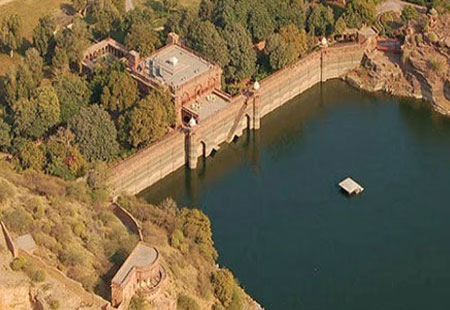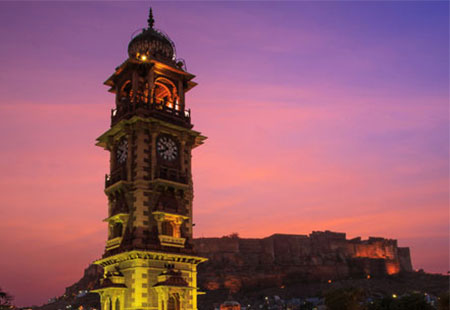Attraction
Mehrangarh Fort
Mehrangarh Fort located in Jodhpur, Rajasthan, is one of the largest forts in India. Built around 1460 by Rao Jodha, the fort is situated 410 feet (125 m) above the city and is enclosed by imposing thick walls. Inside its boundaries there are several palaces known for their intricate carvings and expansive courtyards. A winding road leads to and from the city below. The imprints of cannonball hits by attacking armies of Jaipur can still be seen on the second gate. To the left of the fort is the chhatri of Kirat Singh Soda, a soldier who fell on the spot defending the Mehrangarh fort.
Umaid Bhawan Palace
Umaid Bhawan Palace is one of the world’s largest private residences. Taj Hotels manage a part of the palace. It was named after Maharaja Umaid Singh, grandfather of the present Maharaja Gaj Singh II, this monument has 347 rooms and serves as the principal residence of the Jodhpur royal family. A part of the palace has now been converted into a hotel and a museum.
Jaswant Thada
The Jaswant Thada is a cenotaph located in Jodhpur, in the Indian state of Rajasthan. It was built by Maharaja Sardar Singh of Jodhpur State in 1899 in memory of his father, Maharaja Jaswant Singh II, and serves as the burial ground for the rulers of Marwar. The mausoleum is built out of intricately carved sheets of marble. These sheets are extremely thin and polished so that they emit a warm glow when illuminated by the sun.
Balsamand Lake and Garden
This lake is a popular picnic spot of Jodhpur. It was built in 1159 AD by Balak Rao Parihar. It was constructed as a water reservoir to provide water to Mandore, the then capital of Jodhpur. The Balsamand Lake is surrounded by green garden and has trees like mango, papaya, pomegranate, guava and plum. This place is home for animals and birds like the jackal and peacock.
Kaylana Lake
It is an artificial lake. It receives its water from Hathi Nehar (English: Elephant Canal), which is further connected to the Indira Gandhi canal. The natural vegetation here mostly consists of Babool trees (English: Acacia Nilotic), and various migratory birds such as Siberian cranes are seen here in the winter season. The city of Jodhpur and all the surrounding towns and villages depend on Kaylana Lake as a source of drinking water.
Ghanta Ghar
Ghanta Ghar also known as the clock tower. Beside the tower, there in the Sardar Market that is trusted by tourists for shopping. From this market, you can purchase Rajasthani textiles, clay articles, miniature camels and elephants, marble inlay work and classic silver and gold jewelry.
Rao Jodha Desert Rock Park
Rao Jodha Desert Rock Park was created in 2006 and is situated next to Mehrangarh Fort. There are plants in this park that are adapted to growing in arid, rocky areas of the Thar Desert. Rao Jodha Park is open throughout the year from 9 AM to 5:15 PM every day. Entry Fees for Adults: ₹ 50, Students ₹ 10, Guided Walks ₹ 100 and entry for children aged 15 and below is FREE.
Mandore Garden
The Mandore garden has charming collection of temples and memorials and it’s on high rock terraces. The gardens house the Chhatris (cenotaphs) of many rulers of the state of Marwar. The Mandore Gardens also house a government museum, a ‘Hall of Heroes’ and ‘the temple to 33 crore Hindu Gods’ (The temple of 330 million Hindu Gods).
Machia Bio Park
Machia Biological Park will be opened for public in March which will thus put Jodhpur on the eco-tourism map of the country. Spread over 41 hectare, the Rs 32.30-crore biological park will house lions, tigers, jackals, hyenas, desert cats and desert foxes from different zoos across the country, including Jodhpur zoo. Deputy conservator of forest (wildlife) Mahendra Singh Rathore said efforts are being made to shift animals from Jodhpur zoo to the new shelter due to high levels of air and noise pollution.
Osian Temple
Osian (Osiyan) is an ancient town located in the Jodhpur District of Rajasthan state in western India. It is an oasis in the Thar Desert, and has been known as the "Khajuraho of Rajasthan" for its temples. The town is a panchayat village[1] and the headquarters for Osian tehsil. It lies 69 km (43 mi) by road north of the district headquarters at Jodhpur, on a diversion off the main Jodhpur – Bikaner Highway.
Ramdevra Temple
The village is named after Baba Ramdevji, a Tanwar Rajput and a saint who took Samādhi in 1384 CE, at the age of 33 years. Ramdevji Maharaj took samadhi (conscious exit from the mortal body) in 1459 AD. Maharaja Ganga Singh of Bikaner constructed a temple around the samadhi in 1931 AD. Near the village, there is a tank known as Ramsagar Talab which is believed to have been constructed by Baba Ramdevji himself. A large step well, the Parcha Bavori is also situated nearby.













